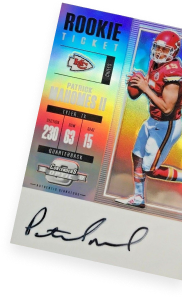2016 Industry Summit Live Blog – Adapt or Die: The Future of Sports Collectibles Retailing

By Ryan Cracknell | Hobby Editor
Adapt or Die: The Future of Sports Collectibles Retailing is a panel discussion at the 2016 Industry Summit.
On the panel are:
- Charlie DiPietro, SportsCards Plus
- DJ Kazmierczak, Panini America
- Angelo Exarhakos, Universal Distribution
- Mike Phillips, Upper Deck
- Doug Caskey, MojoBreak
- Nicole Colombo, eBay
- Kevin O’Neil, Topps
Moderators:
- David Reel, GTS Distribution
- Kevin Isaacson, The Industry Summit
We’ll be live blogging key points in the discussion and updating the post frequently. To get the latest updates, hit refresh.
KI introduces. Goal of discussion is to look at how retailers can be successful in 2020 and beyond.
DR discussing how hobby has evolved into digital age and how retailers can connect with consumers. Goal of panel is to find the reality we’re in right now.
What is a driving force of expanding digital as a manufacturer and what does that do for retail?
Mike Phillips, UD: Our main goal is to expand to more consumers. Right now consumers expect things instantly. It’s about bringing new people into the business.
We’re still not doing enough to create awareness for our great hobby.
So many people use their phone for everything, it’s our job as a manufacturer to reach them.
What we have created is not to cut out the brick and mortar shop. It’s to intertwine.
How does eBay view the collectibles category.
Nicole Colombo, eBay: Collectibles is a new focus for the company. Sports collectibles are 30% of category — the biggest.
Sports collectibles grew 7% in 2015, outpacing many categories.
Fixed-price growing faster than traditional auctions.
43% of eBay sales come from mobile. Important for company for people to browse and research on their phone.
Who is brick and mortar clientele and how has it changed?
Charlie DiPietro, SportsCards Plus: When first opened, things were focused more on smaller transactions. Now it’s bigger.
My customers come in 3 or 4 times per week. They like to bust, trade and sell things on eBay. Return is part of it.
Customers are sharing with each other, happy for each other. Main part of business is now a few people spending a lot of money. I’d like to see more people coming in.
How do you see community in group breaking?
Doug Caskey, Mojo Break: Fun community online. People root each other on. Today we’re seeing more people going after the big hit.
What are some of your top initiatives and how it has changed your products (directed at manufacturers)?
Kevin O’Neil, Topps: When you have an exclusive license you can build different types of products.
As group breaking has become bigger, we’ve changed some configurations to make them more breaker friendly.
For brick and mortar we feel still have several brands that are more set-builder friendly. Example is bigger Topps baseball sets.
When you build a product you want to appeal to as many collectors as possible. This has brought in celebrity autographs in Archives, Allen and Ginter.
D.J. Kazmierczak, Panini America: With exclusive license you can build a broad portfolio. It’s not one size fits all.
Within those different brands you can do things in a different way.
With the advent of mobile phones and tablets and carry over to shops, you have different ways to reach people. There are a lot of opportunities and different ways to build products.
Mike Phillips, Upper Deck: We are very careful with our brands. There are collectors out there that look forward to certain brands returning each year. We have to make sure we’re developing brands that are attractive to new users.
Some brands might not be as profitable but they’re important as entry points. They need to be able to come in and not suffer sticker shock. From there we (manufacturers and dealers) need to show them how to grow their collection.
Is digital the new base brand?
MP: They do go hand-in-hand.
DK: For us, it’s stickers.
KO: There’s a huge amount of people that play the app that don’t buy physical cards. That’s a huge opportunity for all involved to get them to buy the cards.
What are some of the ways distributors have adapted?
Angelo Exarhakos, Universal Distribution: Our job is to engage our hobby partners and help them raise the quality for the collector. Make sure they’re taking advantage of what’s out there.
It’s helping them coach and lead. It’s how to show stores not to be intimidated by group breaking.
Back in the early 1990s, online was ruining the business. A few years later it was eBay, then YouTube.
It’s not up to us to tell consumers how to enjoy the hobby and where to shop. It’s up to distributors to help shops adapt to these trends.
It’s a collaborative effort. A collector who visits a shop on a regular basis is going to be more invested in the hobby and stay in it longer.
How we tie promise and opportunity into trending sales?
Nicole Colombo, eBay: I come from a brick and mortar background. Biggest opportunity is, whether you have store, online presence, eBay creates opportunity to grow your business.
250,000 searches for sports memorabilia per day.
There’s got to be a way that we can advertise and help and reach new people.
People grew up loving cards and inherited cards. eBay provides opportunity to consign with top sellers.
What’s the value of the independent retailer in the industry?
AE: You don’t have an industry without the independent retailer. Whether it’s online or digital cards, you don’t have it without a home base. Without a strong hobby base, it can’t exist. It all ties in to what it really is — a hobby.
The vast majority of people want to interact. You can’t replace the hobby shop. That’s how you create new collectors.
CD: What do I need to do differently in order to make the people across the street or anywhere in San Antonio customers? I looked around and saw cheaper prices so I tried that. But they want to be entertained. That led me to focus on encourage to keep people to stay in the store and build community.
There’s always something going on inside the store. Things like giving away supplies keeps them in the store to open their product. People come in and see people breaking and they want to do it as well.
All I’m doing is keeping collectors in San Antonio happy and keep them coming back. They get to meet with each other and trade. Every night is trade night.
We have to make sure our customers are happy with what they’re doing, entertained and coming back for more.
DC: What I see with Charlie is the passion. Where stores have an advantage is that they can be excited. If you show that passion, prices don’t matter as much. We try to emulate that online but you don’t have the face-to-face that shops have.
CD: If you have someone who has the time to explain things to a new collector who walks in the door, we can bring them into the hobby. Whether that’s to the shop or online, they’ll come back.
MP: Everything that has been brought up is extremely valid. A lot of it depends on how we bring new people into the hobby. Three steps: 1) engagement, 2) educate, 3) cultivate.
What are those things that help you find that new user?
KO: Last year we started “Rediscover.” There were so many people buying in the 1990s that have kids now. They haven’t seen trading cards in ten or 15 years. We’ve centered our advertising around that.
Took my son, his friend and his friend’s dad to shop in Charlotte. His dad used to collect in the 1980s. He was blown away by the changes and spent $100.
We’re giving away cards are MLB games this season and helping them find hobby shops to get more.
With digital, try to get them into physical cards.
DK: We’re promoting the hobby at all levels extensively. We try to be better partners and utilize the tools we have.
AE: In Canada, Tim Horton’s campaign was non-traditional. I don’t think I’ve seen a promotion that brings that many people into a shop.
The guys who really get behind programs like National Hockey Card Day are getting great results.
It’s part of a distributor’s responsibility to get them involved.
NC: On eBay, we’re exposing people who might not be shopping for cards to cards. We focus on cultural moments like the Super Bowl and Kobe Bryant’s retirement.
MP: The basis of National Hockey Card Day is to bring people in for free cards. Many retailers tell us it’s their best day of the year. It’s a great way to get people in.
DC: There are a lot of questions on the case break side. We’ve found success on Facebook, retweet contests and educating them.
What can we do with the opportunity we have to adapt for the future?
DK: There is opportunity versus the best of days have gone by. If you keep an open mind, you can see what might happen. We constantly review market share, demographics. Add analytics to your business. Also, understand you can’t be everything to everyone. Hone in on your customer base or where they’re going to go. How do you be the best person to help them?
Don’t lose sight of the fact that we’re trying to have some fun. It’s an entertainment business. It’s a release. The last thing people want to hear about when they walk in a store is how bad a product is.
I see a lot of diversity but it requires a lot of work.
MP: When you look to the future you see technology. My kids teach me so many things about technology.
Technology can be a little bit scary. Our history has dictated we’re intimidated by technology and set it aside as a passing fad. We have to embrace it and use it to our advantage. We have to look ahead and see how we have tremendous technological advances to our advantage.
KO: I think what you’re going to find is that soccer is going to be one of your stronger sellers going forward. From TV to social media to kids, soccer has turned a corner. You can see it from both us and Panini.
Entertainment, to a lesser degree, there’s a growing curve as well.
AE: Whether it’s 2016 or 2026, the basics aren’t going to change. Shops who focus on that as a base are going to do well.
In the average shop, over the last ten to 15 years is completely different. Those who have been able to keep up with the basics plus technology are the ones who are surviving. Over the next ten or 20 years we’re going to see more improvements.
DC: The ability to take risks is huge.
NC: Look at your own business and look for incremental ways to help it grow.
And that’s all for this panel.





